Unit 4 - Cardiovascular System
1/105
There's no tags or description
Looks like no tags are added yet.
Name | Mastery | Learn | Test | Matching | Spaced |
|---|
No study sessions yet.
106 Terms
What are the four primary functions of the cardiovascular system?
Distribution of blood to meet metabolic demands
enable exchange/delivery of nutrients, wastes, hormones
Role in heat regulation
Essential for hemostasis (clotting)
How is the cardiovascular system organized? Consider the different circuits, the different types of vessels and how they are organized.
It has two circuits - pulmonary circuit, systemic circuit
pulmonary circuit
If blood leaves the right atrium, what heart chambers, valves, and blood vessels will it move through until it reaches systemic capillaries?
What are the 4 valves in the heart, where are they found, and what it is their general structure?
How do cardiomyocytes differ from skeletal myofibers? How are they similar?
Explain what is meant by calcium induced-calcium release in cardiomyocytes?
Why are gap junctions so important for normal heart function?
What is the role of nodal/conducting cardiomyocytes?
What are the 3 components of the cardiovascular system?
Heart - this is the pump that creates pressure to move blood through the rest of the cardiovascular system
vessels - these are the tubes the blood flows through - they include arteries, arterioles, capillaries, venules, and veins
blood - this is the fluid that carries important gases like oxygen, nutrients such as glucose, plus hormones, immune cells, protein, wastes, and more
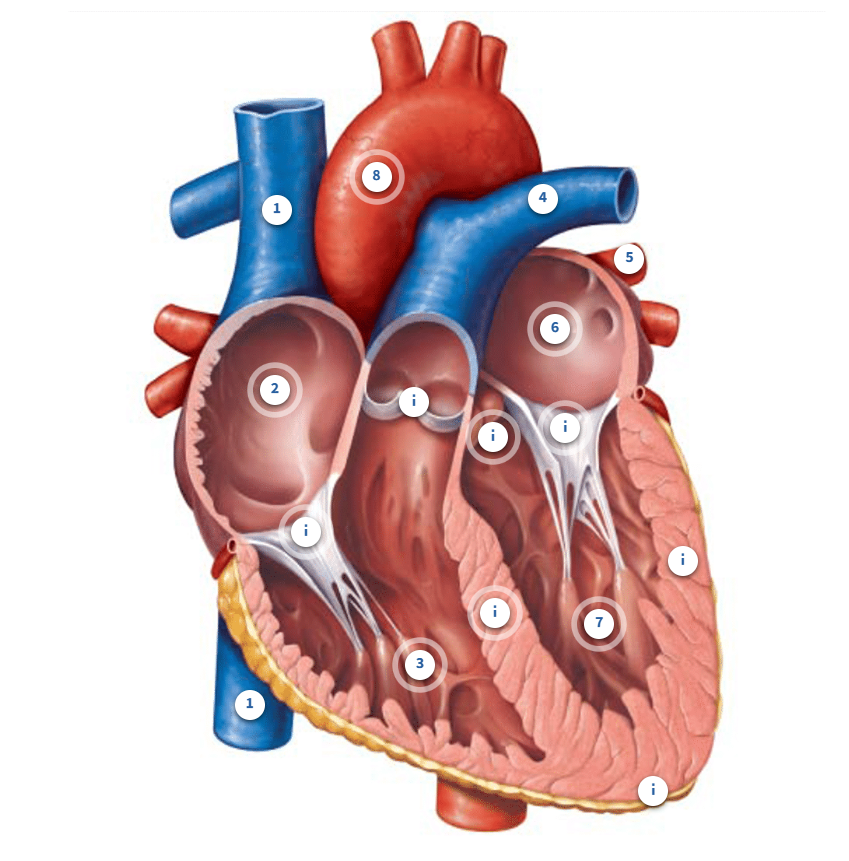
Label the heart
Superior vena cava
the vena cava is the largest vein in your body. Together with the inferior vena cava, they deliver blood back to the right side of the heart from systemic circulation. Blood in this vessel came from your neck, head, chest, and arms
Inferior vena cava
The vena cava is the largest vein in your body. Together with the superior vena cava, they deliver blood back to the right side of the heart from systemic circulation. Blood in this vessel came from your legs and feet plus abdominal and pelvic organs.
Right Atrium
Blood enters the right atrium from the systemic circuit through the vena cava (inferior and superior). Remember that this is blood that is returning from every organ and tissue in your body except your lungs. This will send blood to your right ventricle next.
Right ventricle
This chamber will fill with blood that was in the right atrium. It will send blood out of the heart, through the pulmonary arteries, and into the pulmonary circuit. Blood on this side of the heart has lower oxygen and higher carbon dioxide than the left side because it has collected blood from your systemic organs and tissues where oxygen was dropped off and carbon dioxide was picked up. This is why blood is sent to the lungs next, where it delivers carbon dioxide, a metabolic waste product which we exhale out, and oxygen is added back to the blood.
Pulmonary artery
Blood that enters the pulmonary arteries will head to the lungs, also known as the pulmonary circuit. We have a left and right pulmonary artery to deliver blood to the left and right lung. Remember that arteries carry blood away from the heart.
Pulmonary vein
This is one of the pulmonary veins. You can see another below it and two more tucked in the opposite side of this diagram. We have 2 right pulmonary veins and 2 left pulmonary veins that collect blood from different areas of the right and left lungs. These veins bring blood to the left side of the heart from the pulmonary circuit. In other words, blood that left the lungs is now returning to the left side of the heart. Remember that veins bring blood back to the heart.
Left Atrium
Blood enters the left atrium from the pulmonary circuit through the pulmonary veins. Remember that this is blood that is returning from your lungs. It will be sent to the left ventricle next.
Left Ventricle
This chamber will fill with blood that was in the left atrium. It will send blood out of the heart and into the systemic circuit. Blood on this side of the heart has higher oxygen and lower carbon dioxide than the right side because it has collected blood from your lungs. In the lungs, blood picked up oxygen and dropped off carbon dioxide in order to provide your body organs with appropriate oxygen. That is why your blood is sent out to your systemic circuit next.
What are the valves of the heart
aortic and pulmonary valves
this is where blood passes to leave the ventricles
When looking from the aorta down into the ventricle, you will notice the valve looks like three little pockets. These "pockets" are called cusps. When blood tries to move backward into the ventricle, those cusps fill up with blood, causing them to expand and close, similar to how a parachute may fill with air when skydiving. These 2 valves are sometimes called semilunar valves because of their crescent moon shape.
Atrioventricular valves
Unfortunately, these valves are also referred to by different names. To keep things simple for physiology, we will call them the AV valves since they are found between the Atria and Ventricles. Since the left and right AV valves have different anatomy from each other, they are also often called the mitral and tricuspid valves. You can see that they look different than the aortic or pulmonary valves, which we won't focus on here. What is important is that again, these valves close when blood tried to back up from the ventricle to the atrium.
what is stenosis
If valves do not open properly, a condition known as stenosis, the sound may have a higher pitch.
What are heart murmurs
If valves don't close properly, known as valve regurgitation, a swishing or whooshing sound may be detectable. We call these heart murmurs.
What are the sounds of a stethoscope
As these valves close, it changes the dynamics of blood flow which creates sound. When listening with a stethoscope, a normal heart has two dominant sounds, a "lub" and a "dub". The first sound (lub) is created by the AV valves closing, which happens when the ventricles start to contract and blood attempts to head back to the atria. The dub sound is from the aortic and pulmonary valves closing as the ventricles begin to relax and blood attempts to head back into the ventricles.
WHat are the two types of cardiomyocytes
contractile
Calcium induced calcium release - calcium from the outside made calcium release on the inside, and these are how cardiomyocytes contract
cardiomyocytes have even more mitochondria than skeleal muscle
nodal cells produce APs without neurons
branched cells
they are electrically connected through gap junctions, so cells can share information between the two which is something we dont see with skeletal muscle
they have intercalated discs - look like an egg carton - this keeps the heart cells together bwith desmosomes which is kind of the glue that keeps them together
nodal and conduction
self excitable - they make their own action potenitals to spread through heart for contraction
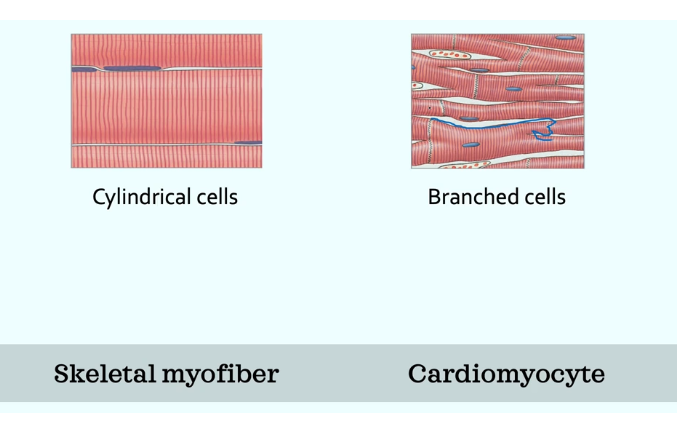
Electrical activity of the heart - how do nodal cells create action potentials
find these nodal and conducting cells at the SA node, AV node, atrioventricular bundles, subendocardial branches
SA node is found in the right atrium, and is commonly called the pacemaker of the heart because it sets how many BPM your heart is going at
SA node has no stable RMP - the lowest it gets is -60mV, and has a -40mV threshold
Sodium and calcium move into the cell to make it more positive, and we try to prevent potassium from moving out
The yellow line in the image is a graded potential called a pacemaker potential - the movement of positive ions is what causes this graded potential, and the nodal cells try to prevent potassium from leaking
Depolarization of the SA node is caused by the opening of calcium voltage-gated channels at the threshold, and then calcium moves in
in repolarization K+ moves out the cell

steps to a heart AP
the SA node spontasiously creates 100 APs a min even if it wasnt connected to anything, but our HR is not typically 100 BPM
due to intrinsic rate
Steps to an AP conduction in the heart
SA node fires
sends AP to atrial cardiomyocytes
then to the AV node - this provides the connection between the atria and ventricles - bit of a pause here before it gets passed in the ventricles - so it allows the atria to finish their contraction so we can get all the blood into the ventricles
to the arterioventrical bundle
then bundle branches (R and L) - travels to both the left and right ventricles so they both contract
subendocardial branches - the ap gets spread from bottom up from the apex in the ventricles, so we can squeeze the blood into the vessels out of the heart - also the AP gets really fast at this point
ventricular cardiomyocytes contraction from bottom up

What would happen if the SA node failed
If the SA node were to fail, the AV node could take over as the pacemaker, since it is the next fastest to create action potentials. This would then spread the action potential to the ventricles via the conducting system we studied earlier.

How would your HR slow down or speed up
For slower HR the NT will be working with the mucanistic receptors
when ACh binds to the mucanistic receptors from increased activation of the parasympathetic nervous sytem. this will decrease the permeability of sodium into the cell, so it takes longer to become positive, and it also allows more potassium to leak out
For a faster HR we are going to activate our sympathetic nervour system
there is a chemical response from the release of NT from the sympathetic nervous system, and these activate the androgenic receptors on the cell - the receptor will bind to the NT released by the SNS - this NT is norepinephrine - because of this, the cell becomes even more permeable to sodium and leaks out less potassium to get the cell positive quicker
Whats an ECG
The electrocardiogram (ECG), sometimes also called an EKG, gives healthcare providers important information about the electrical activity in the heart. During this test, 10 sticky disks, known as electrodes are placed in various locations on the skin of the chest, arms, and legs. Depending on how the information is recorded, it can give 12 "views" of the heart's electrical activity from different directions. For example, from the front of the heart or sides of the heart. Therefore, it is referred to as a 12-lead ECG. It can be used to help diagnose heart arrhythmias, heart attacks, and conduction issues of the heart.
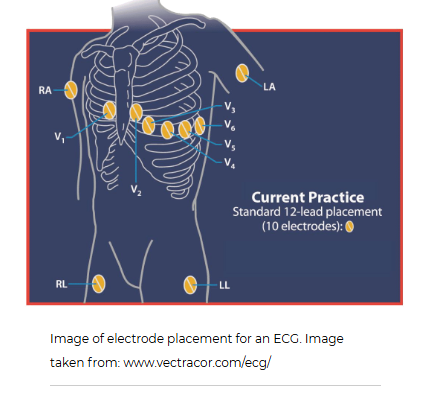
What is the P wave, QRS wave, and T wave
P wave
This electrical event is the result of DEPOLARIZATION of the atria of the heart. Please remember this is not measuring a single action potential but the sum of all action potentials occurring in the atria. If you were to measure the time from the start of 1 P wave to the next P wave, you could determine heart rate.
QRS wave
This electrical event is the result of the DEPOLARIZATION of the ventricles. Notice how much larger it is than the P wave. This is because the ventricles have a much larger mass and, therefore, more cells than the atria. With more cells comes a larger electrical event.
Measurements of the time it takes from the P wave to the start of the QRS wave (PR interval) can indicate whether electrical conduction is normal between the atria and ventricles. Other measurements, like the Q-T interval, can give indications about cardiac conditions. There are a variety of measurements that are done that are beyond the scope of this course.
T wave
This electrical event is the result of the REPOLARIZATION of the ventricles.
It is important to point out that repolarization is also "up" in the ECG. During the action potential, you have always seen repolarization as making the voltage of a cell more negative. In fact, all three of these waves (P, QRS, and T) have an upward (more positive) and then downward (more negative) component. That is because the direction of the wave (up or down) is determined by the direction of the electrical activity toward a particular electrode. If the electrical activity is heading toward that electrode, it is shown as an increase in voltage. As that electrical activity is heading away from that same electrode, it measures a decrease in voltage. It is more complicated than this, but hopefully this makes sense. In other words, do not confuse what is seen in the ECG to what you learned about for action potentials. Again, these are not individual action potentials.

Wait, what about the atria? If they depolarize, why don't they also repolarize?
Well, they do. The atria repolarize at about the same time as the QRS wave. And because the atria are smaller, their repolarization is masked by the large QRS activity as the ventricles are depolarization. So we don't see a unique wave created by atrial repolarization like we do for ventricular repolarization.
From an ECG, cardiac arrhythmias, a myocardial infarction (heart attack), damaged heart muscle, conduction problems, and a host of other cardiac conditions can be detected.
What are the 5 phases of the cardiac cycle
Isovolumetric ventricular systole: this is when the ventricles start contracting but they aren't yet able to pump blood out of the heart. Hence the term isovolumetric is used, as the volume of the ventricles don't change. Iso means equal in Greek.
2
Ventricular systole: this is when the ventricles are contracting AND moving blood out of the heart and into the aorta (L ventricle) or pulmonary arteries (R ventricle).
3
Isovolumetric ventricular diastole: this is when the ventricles start relaxing but they aren't yet able to fill with blood. Again, notice the word isovolumetric here since ventricular volume isn't changing.
4
Late ventricular diastole: this is when the ventricles are relaxing AND starting to fill with blood from the atria.
5
Atrial systole: this is when the atria are contracting, moving blood into the ventricles.

Ventricular systole: 2 phases
Phase 1: isovolumetric ventricular systole
in this phase, the QRS wave occurs, and this is because there is a delay between the electrical impulse vs the actual contraction
there is no change in volume
the valves are not open
there is a large increase in ventricular pressure
Phase 2: Ventricular systole
this is where ventricular pressure becomes higher than aortic pressure
the aortic valve is open, and the AV valve is closed
decrease in volume of the ventricles
this is where the volume of the ventricles is at its lowest, but its important to note that the heart never fully empties
Ventricular diastole: 2 phases
Phase 3: Isovolumetric Ventricular Diastole
in this phase all the valves are closed
we get a decrease in ventricular pressure as it is relaxing, and we get higher aortic pressure
theres no volume change
T wave in phase two, but this carries over into phase 3 and finishes here
Phase 4: Late Ventricular Diastole
flat ECG line
increase in ventricular volume, as it is filling
since the ventricle is filling, this means the AV valve is open and letting blood flow through
the ventricular pressure dropped below the atrial pressure, which is what allowed blood to start flowing in, at this time the aortic pressure is also slightly decreasing
Phase 5: Atrial Systole
increased ventricular volume, which means the AV valve is still open
decreased ventricular pressure, and increased atrial pressure
ECG - P wave in phase 4
End systolic volume (ESV)
is the amount of blood remaining in the ventricles at the end of systole (hence the name) after the ventricles have contracted. It indicates the efficiency of the heart's pumping ability. A lower ESV typically means the heart is contracting more effectively, while a higher ESV may indicate heart dysfunction.
In the diagram below, ESV is equal to 60 mL. You do not need to memorize this number.

End diastolic volume (EDV)
is the amount of blood in the ventricles just before ventricular contraction. Remember, the ventricles have the maximum volume after ventricular diastole once the atria have finished their final "top up" during atrial systole before the ventricles start contracting again. So, here the name makes sense again!
In the diagram below, EDV is about 130 mL. Again, you do not need to memorize this number.

Stroke volume (SV)
Stroke volume (SV) is the amount of blood pumped out or ejected by the ventricles with each heartbeat. Stop for a moment and consider how you might calculate how much blood leaves the heart. Think about the two volumes (EDV and ESV) we have discussed already.
If we know how full the ventricle was (EDV) and how much remained after it contracted (ESV), we can easily determine how much blood left the ventricle in that heartbeat. It is calculated by subtracting the end systolic volume (ESV) from the end diastolic volume (EDV). Therefore, an increase in EDV or a decrease in ESV can lead to a higher stroke volume. Looking at this as an equation:
SV = EDV - ESV
In the diagram below, stroke volume would be calculated to be 70 mL, since EDV is 130 mL and ESV is 60 mL on this graph.
Stroke volume is an important indicator of heart health as it influences a person's cardiac output, which we will discuss next. Stroke volume is affected by several factors, including preload and cardiomyocyte contractility. We will look at how these two factors influence stroke volume shortly.
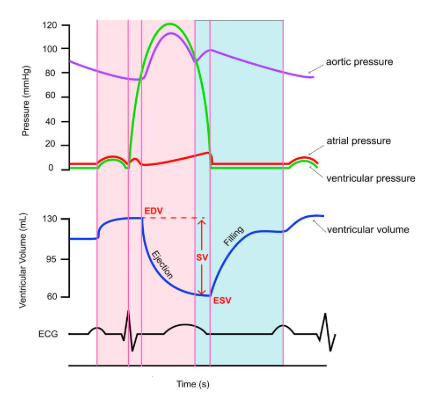
Cardiac Output (CO)
Cardiac output (CO) is the amount of blood the heart pumps per minute. This is often what is used clinically as a measure of heart function and overall cardiovascular health. Cardiac output is determined by two main factors: heart rate and stroke volume.
Heart rate refers to the number of times the heart beats per minute, while stroke volume is the amount of blood pumped with each beat. Therefore, to calculate this:
CO = HR x SV
For example, if someone's heart rate is 70 beats per minute and their stroke volume is 70 mL, their cardiac output would be 4900 milliliters per minute, or 4.9 liters per minute. A typical cardiac output at rest is about 5 - 6 litres per minute.
Cardiac output is essential for maintaining adequate blood flow to all your tissues and organs. It ensures that proper oxygen and nutrients are delivered to cells, and waste products are removed. Without sufficient cardiac output, the function of organs and tissues will be impaired.
Keep in mind that anything affecting heart rate or stroke volume will impact cardiac output.
What controls stroke volume
ANS Innervation
the SA node has muscarinic and androgenic receptors
sympathetic - innervates ventricular cardiomyocytes by norepinephrine/epiniephrine binding to androgenic receptors
the NT (nor) or hormone (epi) bind to andregenic receptors and create a larger stroke volume because as they bind they increase calcium permeability, so this increases the strength of contraction
parasympathetic - only some innervation to contractile cardiomyocytes by ACh binding to muscarinic receptors
this decreases calcium permeability so less CA2+ goes out from the SR into the cytoplasm
Preload on the heart (EDV)
because of frank sterling’s law if we increase the volume in the ventricle we will still end up with the same ESV, so if we put in more we get a bigger SV

what is the distribution of blood volume between our pulmonary and systemic circuit
pul - 15%,
sys 85%
arteries - 10%
capillaries - 5%
veins - 70%
What is the anatomy of a blood vessel
blood passes through the center of the tube called the lumen - similar to looking at the top of a paper towel roll
Tunica externa: this is the outermost layer composed mostly of connective tissue which functions to protect the vessel, adhere it to surrounding tissues, and maintain its appropriate structure. We can find neurons of the sympathetic nervous system, which communicate with the tunica media beneath this layer. In larger arteries and veins, we even find blood vessels in this layer. This ensures that the cells making up the walls of these vessels receive proper oxygen and nutrient delivery. It probably seems odd to think that blood vessels can have blood vessels too!
Tunica Media: this is the middle layer that contains smooth muscle, which like skeletal muscle, can contract or relax to various stimuli. Smooth muscle will change the diameter and, thus, the size of the lumen of the vessel. There are also elastic fibres, called elastin. Elastin allows vessels to stretch and recoil back to their resting shape, much like an elastic band would. We also find collagen here, a protein that is common in connective tissue. Different types of blood vessels differ in their proportion of smooth muscle, elastin, and collagen in their tunica media as you will see.
Tunica Interna: this is the innermost layer, composed of special cells that line all blood vessels. These cells are known as endothelial cells. This layer is important for normal vessel function.

Pressure distribution of arteries and veins
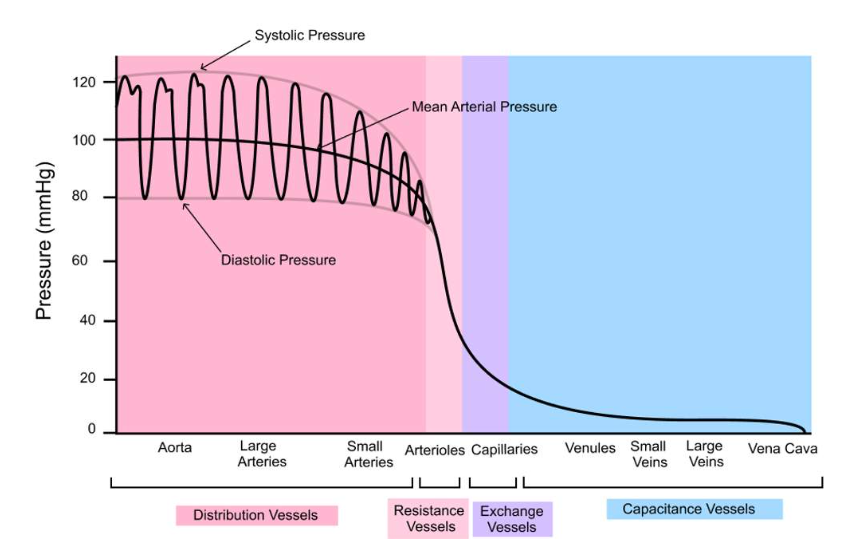
How vessels differ: Structure and function
Arteries: These vessels are tasked with carrying blood away from your heart to the various organs and tissues of your body. Therefore, we refer to them as distribution vessels. These are large diameter blood vessels, and their wall is about 25% as thick as their diameter (Fig. 1). They have a lot of elastin in their walls, enabling them to stretch much like an elastic band would. This is important since they are receiving blood during ventricular systole, requiring them to stretch, but can then recoil or "unstretch" during ventricular diastole to keep moving blood through the cardiovascular system. Otherwise, blood flow would be disrupted during diastole when the heart is relaxed. Compared to smooth muscle, elastin is the most abundant structure in the tunica media of arteries.
Arterioles: These are smaller than arteries, but notice that relative to their diameter, they have thick walls. Their wall is about 50% as thick as their diameter, much more than arteries (Fig. 1). These thick-walled vessels are often referred to as our resistance vessels due to the vast amount of smooth muscle, rather than elastin, that dominates their tunica media. This smooth muscle can contract and relax to various stimuli so that the lumen diameter can become smaller or larger, respectively. You see a huge drop in blood pressure here (Fig. 2). We will discuss why that happens later on, but it is related to their overall resistance to blood flow.
Capillaries: These are our smallest blood vessels, composed of only a single layer of endothelial cells. As you can see, they have extremely thin walls (1 um = 1/1000 mm) (Fig. 1). Their purpose is to act as exchange vessels. Oxygen will leave the blood and enter the cells of your tissues and organs, and so will nutrients, and ions. Hormones will leave capillaries to bind to their receptors on target cells, along with other small molecules. Blood will also pick up wastes like carbon dioxide and many others, so our body can eliminate them. Blood pressure is lower in these vessels than in arterioles (Fig. 2)
Venules: Blood leaves capillaries and flows into these vessels next. In order for blood to flow, the pressure in the venules has to be lower than in capillaries. We won't look at these vessels in any more detail.
Veins: These vessels carry blood back to our heart from your organs and tissues. As you saw at the start of this session, they happen to contain the majority of our blood volume (70%). Therefore, we refer to them as capacitance vessels, because they have the capacity to hold blood. These are large diameter but thin-walled vessels. Their wall thickness is only about 10% relative to their diameter (Fig. 1). This probably makes sense since the blood flowing through them has a very low pressure, unlike arteries (Fig. 2). They don't need such thick walls to be able to withstand the high pressures that arteries do!
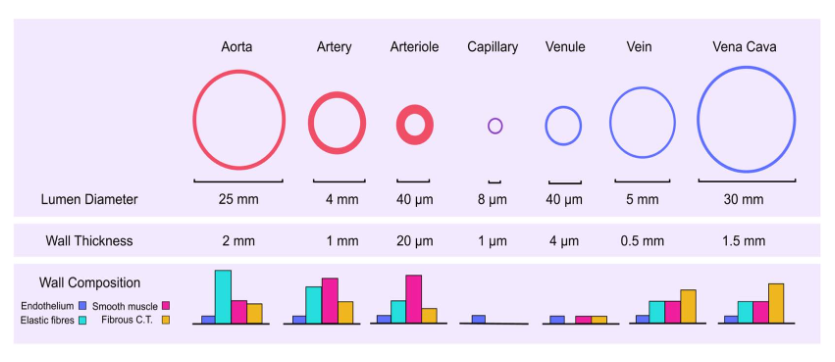
what is the distribution of cardiac output at rest

Arteries structure, blood characteristics and purpose
distribution vessels
structure
large diameter
thin walls compared to diameter
lots of elastin fibres
easy to stretch
blood characteristic
very high blood pressure
pulsatile with very small drop in pressure
purpose
shock absorbers
Arterioles structure, blood characteristics and purpose
Resistance vessels
structure
small diameter
thick walls compared to diameter
lots of smooth muscle
smooth muscle innervated by SNS
blood characteristics
large drop in pressure since lots of resistance
purpose
controls blood flow (vasoconstriction, vasodilation from the tunica media)
What is the blood flow equation
bf = pressure gradient / resistance
R = Ln/r4 R= resistance, L = length, n = viscosity, and r4 = radius
What are the mechanisms used to regulate blood flow
local (intrinsic) - tissue environment (temp, gases, pressure)
these mechanisms involve changes in the conditions of the organ or tissue itself. We say they are INTRINSIC mechanisms since the stimulus to change blood flow comes from within the very tissue or organ that needs it.
humoral (extrinsic) - Substances in blood)
these mechanisms involve substances that are travelling in the blood through the blood vessels of the tissue/organ. These substances will change the radius of the blood vessels, often by binding to receptors that recognize that substance. Some substances will cause vasodilation and others will cause vasoconstriction. Often this type of regulation involves hormones produced elsewhere in the body. Therefore, we consider this to be a type of EXTRINSIC mechanism, since the signal to change blood flow came from outside the tissue/organ.
Neural (extrinsic) - nervous system
neurons from the sympathetic nervous system innervate the smooth muscle cells found in the tunica media of many of our blood vessels. These neurons release the neurotransmitter norepinephrine that you saw in session 2. Norepinephrine binds to adrenergic receptors to cause vasoconstriction which will reduce blood flow. This is also an EXTRINSIC mechanism since the neurons originate from outside of the tissue/organ.
How does movement occur in the capillary, and what are the two kinds of plasma membranes
Movement may be from the plasma within a capillary out to the interstitial fluid surrounding a capillary, or from the interstitial fluid back into the plasma. As seen in the diagram below, substances passing through the endothelial cell actually have to encounter TWO plasma membranes, the one closest to the capillary lumen, called the luminal membrane, and the one closest to the interstitial fluid, called the basolateral membrane. You can think of this as the cell having a "top" and a "bottom".
Substances moving across the epithelial cell this way use transcellular transport, meaning the substance has to actually enter and then exit the endothelial cell.
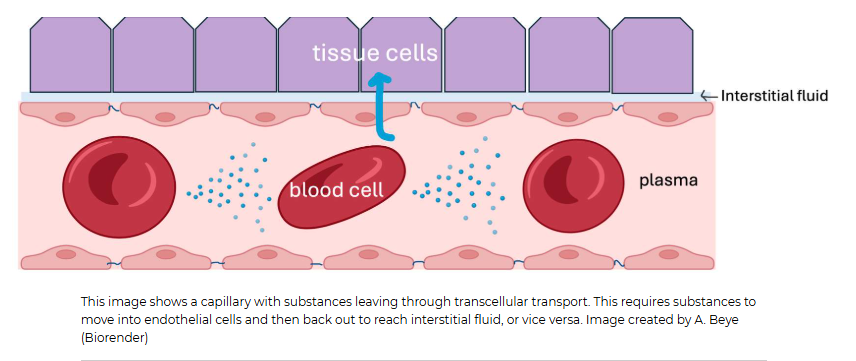
What kind of transport occurs between two endothelial cells lining the capillaries
This type of transport is called paracellular transport. Para in Greek means beside. We tend to refer to this type of movement as bulk flow since fluid and anything dissolved in it (ions, hormones, glucose, wastes, drugs) that are small enough to fit through that intercellular cleft will flow through it. Bulk flow isn't very selective apart from size. This is one reason why the ion concentrations between the plasma and interstitial fluid are very similar! Proteins, on the other hand, cannot fit through these clefts. That is why the interstitial fluid has different protein concentrations than the plasma does.
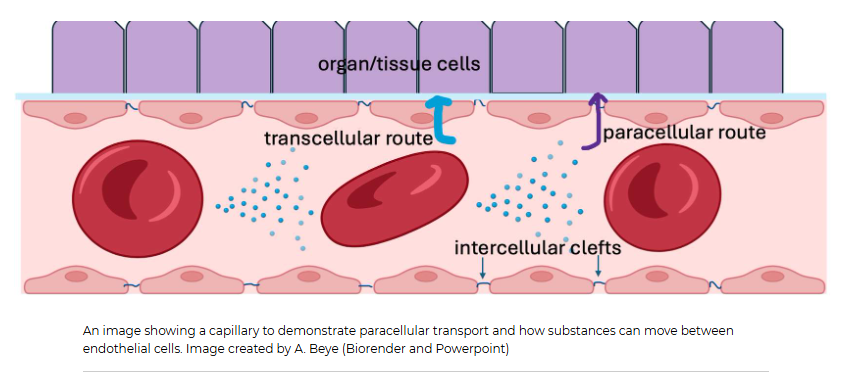
What are the 3 types of capillaries we have in our bodies
We have a few different types of capillaries in our body. Continuous capillaries are the most abundant capillaries. But we also have fenestrated capillaries, found in the kidneys and intestines, and sinusoidal capillaries of the liver and spleen. These different capillaries have different permeability or "leakiness" to bulk flow.
Continuous capillaries are much less permeable than fenestrated capillaries. Both capillaries have intercellular clefts, which you learned about above. These small slits are found at the border where two endothelial cells meet. But
fenestrated capillaries also have pores that go directly through the endothelial cell. These fenestrations are a bit like tunnels that allow substances to pass from inside the capillary directly into the interstitial fluid surrounding it.
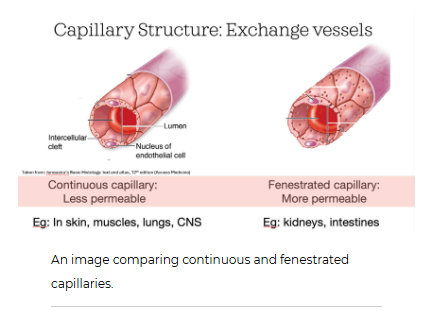
Continuous capillaries
These are found in our muscles, brain, lungs, heart, and many other organs. Continuous capillaries themselves can also vary in their permeability or leakiness. Some have wider intercellular clefts between endothelial cells while others have almost none at all. The brain is a great example of continuous capillaries with almost no permeability through intercellular clefts. This is important because if we had a lot of fluid leak out of capillaries in our brain, this could lead to problems as it is encased in a hard bony skull and can't expand!
The permeability of the intercellular clefts is related to proteins responsible for linking two endothelial cells together. These proteins form tight junctions. The "tighter" the tight junction, the narrower the intercellular cleft, like in the blood-brain barrier. The size of these clefts will determine what substances can pass in between cells and which can't. This is much like a kitchen colander/strainer that will allow water and salt to pass through it, but not the spaghetti noodles you may make for dinner! Cells and proteins typically cannot pass through these clefts.
What is the role of the lymphatic system in regards to capillary filtration?
they are vessels that return ISF to the circulation, because we always get more filtration than reabsorption, so the lymphatic system helps out with that.
What are the two autoregulatory mechanisms for local regulation
myogenic theory
Muscle stretch
this means that the tissue itself can dictate how much fluid is coming through by changing the radius on the vessels
increased BP will caused increased stretch in arteriole which them would casue a reflexive contraction to reduce radius (vasoconstrict)
this will cause a dropin blood flow because this theory means theres too much blood going into this tissue
metabolic theory
metabolic needs
increased CO2, H+, adenosine, temp
decreased O2 because it is using more
this tissue is more metabolically active
so the vessels have to change radius to supply more blood flow (vasodilation)
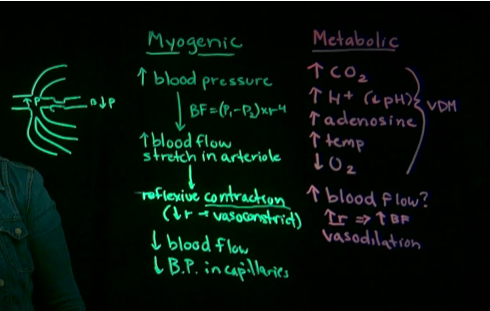
Humoral regulation of blood flow
vasoconstricting substances
Epinephrine, also known as adrenaline, is a hormone released by your adrenal glands whenever the sympathetic nervous system is activated. Epinephrine binds to adrenergic receptors on the smooth muscle cells of blood vessels. We actually have different types of adrenergic receptors. Here, epinephrine binds to ALPHA adrenergic receptors to cause vasoconstriction and reduce blood flow through those vessels. This will also result in an increase in blood pressure as we will discuss later.
Angiotensin II (two) is a hormone that is part of a complex production pathway that you will learn about when you study renal physiology. Angiotensin II binds to receptors on the smooth muscle cells of blood vessels causing them to vasoconstrict and thereby increase blood pressure. Interestingly, a stimulus for angiotensin II production is LOW blood pressure.
Antidiuretic hormone (ADH), also known as vasopressin, is released by an area of the brain called the posterior pituitary gland. You will also learn about this when you study renal physiology since it acts on the kidneys to promote water reabsorption back into the blood. This way not too much fluid is lost in urine. But it also causes vasoconstriction by binding to receptors on the smooth muscle cells of blood vessels. As with angiotensin II, a stimulus for ADH release is low blood pressure. By causing both vasoconstriction AND returning fluid back into circulation, we can raise blood pressure.
In summary, all of the substances listed here are hormones that cause a decrease in the radius of blood vessels like arterioles. You learned that whenever you have vasoconstriction of arterioles, you can expect the pressure in the arteries to go up since pressure before the "pinch" increases. This is why each of these causes a rise in your blood pressure, which is measured from arteries.
Vasodilating substances
Histamine is a chemical released by inflammatory cells during allergic reactions and other inflammatory conditions. It is NOT a hormone. It binds to receptors on blood vessels, causing them to vasodilate and increase blood flow to the area. This helps move immune cells to the affected area. During a major allergic reaction, like anaphylaxis, blood pressure will drop. Hopefully this makes sense, vasoconstriction will RAISE blood pressure but vasodilation will decrease it.
Atrial natriuretic peptide (ANP) is a hormone produced by the atria of the heart in response to increased blood pressure. ANP promotes vasodilation by binding to its receptor and relaxing the smooth muscle cells in blood vessel walls. This vasodilation will then reduce blood pressure. You will learn more about ANP in the renal physiology unit as it also affects the functions of the kidneys.
Epinephrine. Wait, what??? Didn't we just learn that this hormone caused vasoconstriction? Yes, you did. But recall that we said there are different types of adrenergic receptors. When it binds to ALPHA adrenergic receptors, you will get vasoconstriction of arterioles. But if epinephrine binds to BETA adrenergic receptors, you will get vasoconstriction. Interesting, right? It is the same hormone, with different responses depending on the receptor it binds. So, do some blood vessels have alpha-adrenergic receptors, and others have beta-adrenergic receptors? YES! Imagine a fight-or-flight response. If you had widespread vasoconstriction, you would reduce blood flow to your skeletal muscles as well, which is not a good thing for a fight-or-flight situation. Arterioles in skeletal muscles have beta-adrenergic receptors that will trigger vasodilation in those blood vessels, while many other blood vessels will experience vasoconstriction as epinephrine binds to alpha receptors on those vessels.
How do we calculate mean arterial pressure
MAP is the average pressure of the arteries, and since the arteries spend more time in diastole, the equation is
MAP = diastolic pressure + 1/3 (systolic pressure-diastolic pressure)
MAP = CO x TPR
if cardiac output or total peripheral resistance changes, then this can affect the MAP
Baroreceptor Reflex and MAP
he negative feedback system used for blood pressure homeostasis is called the baroreceptor reflex. It is critical for maintaining mean arterial pressure (MAP) within a narrow range, ensuring stable blood pressure and appropriate blood flow. Stretch receptors, known as baroreceptors, detect changes in blood pressure and send signals to the medulla oblongata of your brainstem. This initiates a negative feedback loop that adjusts heart rate, stroke volume, and blood vessel diameter to stabilize MAP.
When mean arterial pressure deviates from the normal set point, the reflex quickly counteracts these changes, preventing potential damage from prolonged hypertension or hypotension. These fast changes involve activation of the parasympathetic or sympathetic nervous system
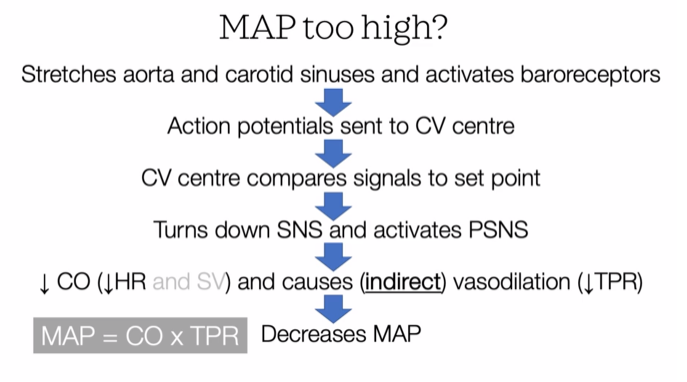
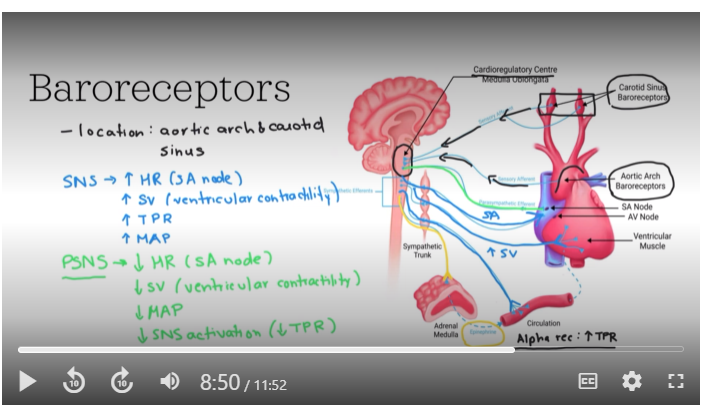
What are the 7 functions of the kidney
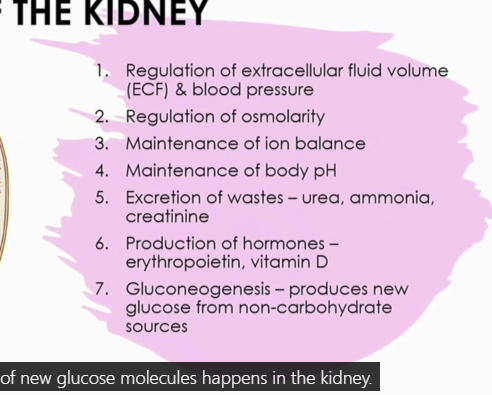
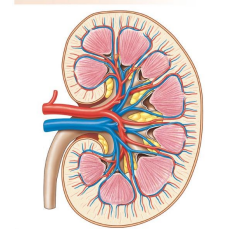
Anatomical structure of the kidney


Label the nephron
often have 4-5 nephrons connecting to one connecting duct

The Renal Corpuscle
The renal corpuscle is the part of the nephron that filters blood and produces a fluid called the filtrate and is made up of three components…
1
Bowman's Capsule - Where fluid filters into
2
Glomerulus - Specialized leaky capillaries
3
Juxtaglomerular Apparatus (JGA) - Junction of the tubule and arterioles around Bowman's capsule
is a fluid-filled hollow ball-like structure that surrounds the glomerulus. The capsule is continuous with the beginning of the first part of the tubule, which is termed the proximal tubule. The cells that make up the outside of Bowman’s capsule are simple flattened-looking cells called epithelial cells (shown in yellow in this image). The cellular part of Bowman’s capsule that physically contacts the glomerulus is a specialized type of epithelial cells called podocytes (shown in purple).
Another important structure is the juxtaglomerular apparatus (JGA). The JGA is composed of the junction of a part of the tubule that is called the late ascending limb of the loop of Henle, which passes in between the two blood vessels that enter and exit the corpuscle called the afferent and efferent arterioles. Specialized cells in the late ascending limb of the loop of Henle are called macula densa cells. These cells can detect the concentration of sodium and chloride in the filtrate as it passes through the tubule. The cells just beside the macula densa are called the juxtaglomerular cells (also known as granular cells), which are responsible for producing and releasing an important enzyme called renin. The function of renin will be discussed in upcoming sessions.
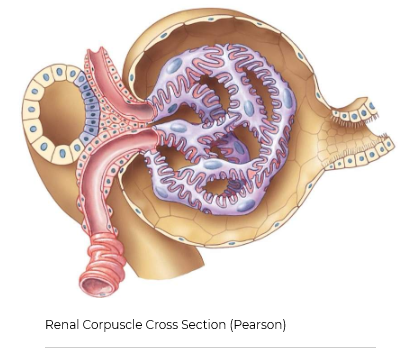
What are the two types of nephrons, and what are their differences?
Nephrons are positioned in two different ways within the layers of the kidney. Nephrons are categorized based on this positioning and some anatomical differences, as being either a cortical nephron or juxtamedullary nephron. Both nephron types still filter blood similarly, and both process the fluid that is filtered in much the same ways as the filtrate fluid passes through the tubule segments.
Humans have many more cortical nephrons than juxtamedullary nephrons. Approximately 80% of all nephrons in a human kidney are categorized as cortical, whereas 20% are juxtamedullary. The ratio of the two types of nephrons varies between species. There are some key anatomical differences between these two types of nephrons that result in the additional ability of juxtamedullary nephrons to conserve more water.
jux has a long loop of henle
cortical has peritubular loop capillaries- job is to reabsorb filtrate
jux are crucial for concentrating urine and conserving water. They are characterized by their location near the medulla and their long loops of Henle, which are essential for creating the conditions needed for urine concentration
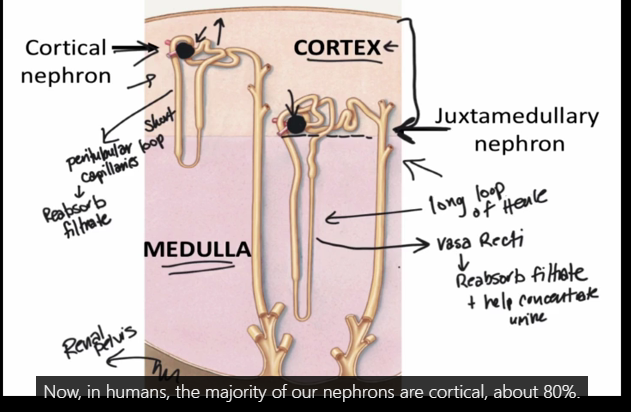
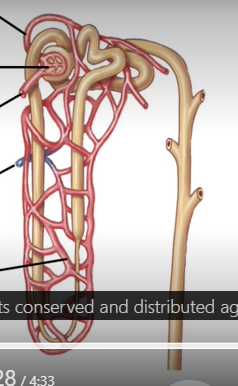
Blood flow to the kidneys
20% of CO goes to the kidneys
afferent arteriole
brings blood to the kidney
Glomerulus
capillary bed inside of the corpuscle
efferent arteriole
takes blood away from kidneys
Pertibular capillaries - vasa recti for the jux nephron*
wrap around the tubule
respinsible for reabsorption
venule
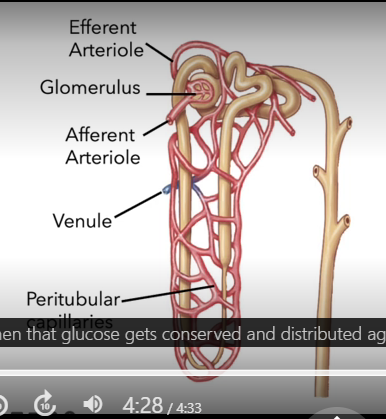
Processes of the Nephron
Our kidneys produce 180 litres of filtrate per day. However, we only excrete approximately one and a half to two litres of urine a day. Therefore, most of the filtrate that is created must be reabsorbed back into our body so that it is not excreted as urine. Three processes of the kidney will affect how much fluid and what in that fluid is excreted (E); filtration (F), reabsorption (R) and secretion (S).
Filtration
The movement of fluid and the items dissolved in the blood from the glomerulus into the space of Bowman's capsule is called "Filtration". The fluid that enters Bowman's space is called filtrate. Filtration is a process that only occurs with the renal corpuscle.
Reabsorption
The movement of items from the filtrate within the tubule back into the surrounding capillary bed is called reabsorption. Most of the fluid that is originally filtered, is reabsorbed. Contents of the filtrate that are reabsorbed include water, ions, glucose and amino acids. The capillary bed that surrounds the tubule of a cortical nephron is the peritubular capillaries. These capillaries are very similar to the vasa recti capillary bed that surrounds juxtamedullary nephrons.
secretion
Items dissolved in the blood can also be added into the filtrate as it travels through the tubule. The movement from peritubular (or vasa recti) capillaries is called secretion. These are items that may not have had an opportunity to be filtered within the corpuscle and often include medications that our body is trying to remove at a quicker rate than these items can be normally filtered within the corpuscle.
Excretion
The filtrate that is collected in the renal pelvis, and then collects in the bladder is called urine. Urine is what is excreted from the body and the production of urine is called Excretion (E). The contents of urine is due to the earlier processes within the nephrons; Filtration (F), Reabsorption (R) and Secretion (S). The items excreted in urine are therefore due to how much of each item that was filtered, minus how much of that item was reabsorbed plus any more of that item that was secreted into the tubule.
Formula for Excretion
Filtration (F) - Reabsorption (R) + Secretion (S) = Excretion (E)
In other words:
In order to be excreted in urine, the item (ie solute) must be first filtered (F). If the item is then reabsorbed (R), it is therefore not excreted, so that is subtracted from the formula. If an item is secreted (S) into the filtrate (and not subsequently reabsorbed again), it will be part of what is excreted.
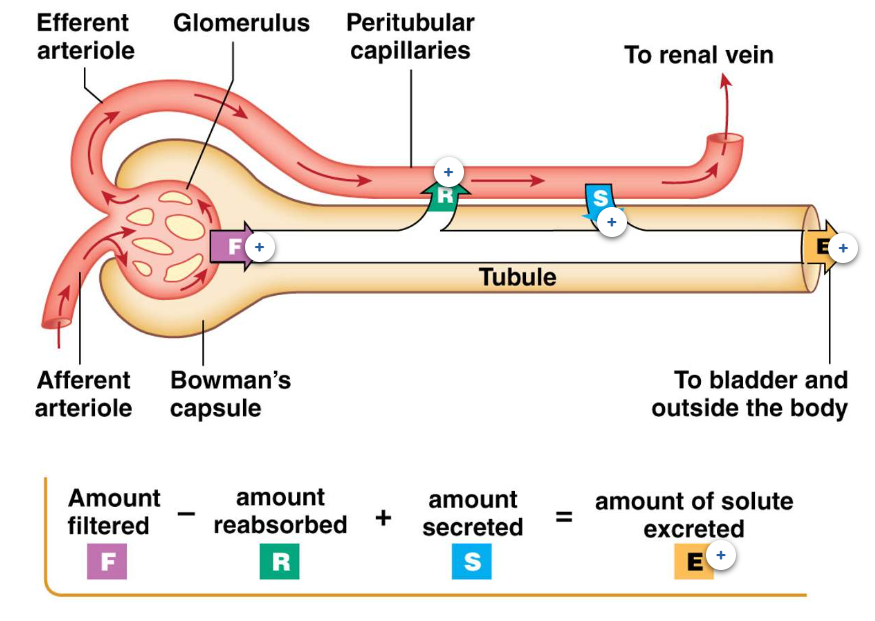
What are filtration barriers
The glomerulus is a unique capillary bed because it contains many fenestrations, also known as pores, making it quite leaky so that most everything in the blood, red and white blood cells, could filter into Bowman’s space. However, due to some more barriers within the corpuscle, proteins are also restricted from filtering into Bowman’s space.
Recall that the cells of the capillaries are called endothelial cells. The endothelial cells of this capillary are physically fused with the podocytes of Bowman’s capsule. These two cell layers are adhered together with a sticky extracellular matrix, called the basal lamina, which is composed of collagens and negatively charged glycoproteins. The basal lamina serves as a sieve to further filter and exclude plasma proteins from entering Bowman’s capsule.
Podocytes serve as the third barrier to filtration. Podocytes have long finger-like projections, also called pedicels, that wrap around the glomerulus and interlace with each other. The narrow slits between each podocyte are where the fluid coming from the blood may filter into Bowman’s space. The slit spaces in between podocytes can narrow or widen, which will affect how much fluid can filter into Bowman’s space.
Barriers to Filtration
There are three barriers within the corpuscle that will limit what items can be filtered from the blood into Bowman's space.
1
Size of the endothelial pores (fenestration) and size of the spaces in between endothelial cells.
2
The space in between the fibres of the basal lamina.
3
The spaces in between the podocytes.
A full urinalysis generally has three types of measurements:
VISUAL INSPECTION - Although normal/healthy urine should be a light yellow colour, many other colours can be observed (such as green, blue, brown, and red) which may or may not cause concern. Clear urine indicates that a person is likely overhydrated, whereas urine that is much darker yellow can indicate dehydration. Urine should also be clear, and if particles or frothing are observed, these suggest issues such as early signs of kidney stones (particles observed), and the presence of bacteria (milky) or proteins (frothy) in the urine.
MICROSCOPIC EVALUATION - Early signs of kidney stones can be diagnosed if sediments and/or small crystals are observed in the urine sample. Bacteria can be visualized using microscopic evaluation, which would confirm a urinary tract infection. If red blood cells are also observed together with bacteria, this usually indicates a urinary tract infection. However, there are other causes of red blood cells in the urine, such as types of urinary tract cancers. The cause of the red blood cells in urine requires more extensive evaluation to rule out a cancer diagnosis.
CHEMICAL ANALYSIS - Most urine test strips will test for items such as glucose, proteins, bilirubin, ketones and white blood cells (leukocytes). For these measurements, we expect to see no presence of any of these in healthy urine. We will learn in later sections, that although glucose can easily filter into Bowman's space, no glucose should be observed in urine. If glucose is observed in urine, this can indicate that the patient has diabetes mellitus.